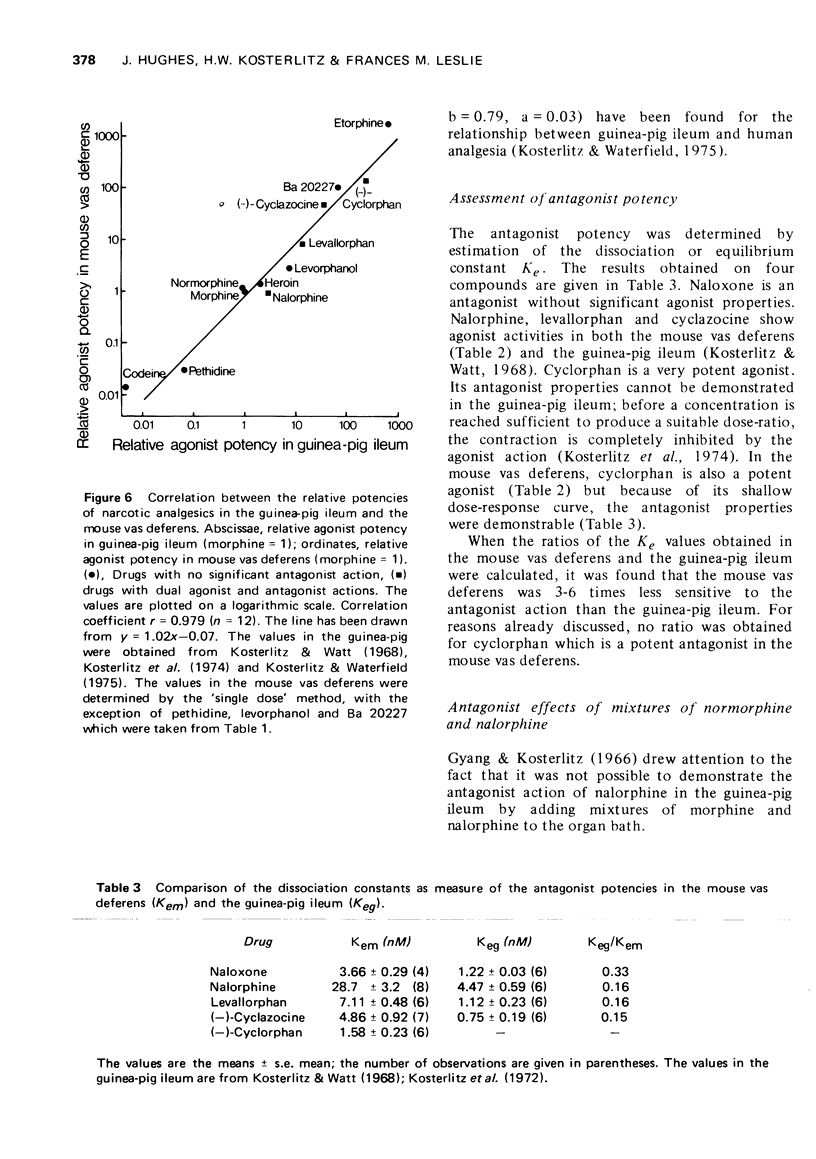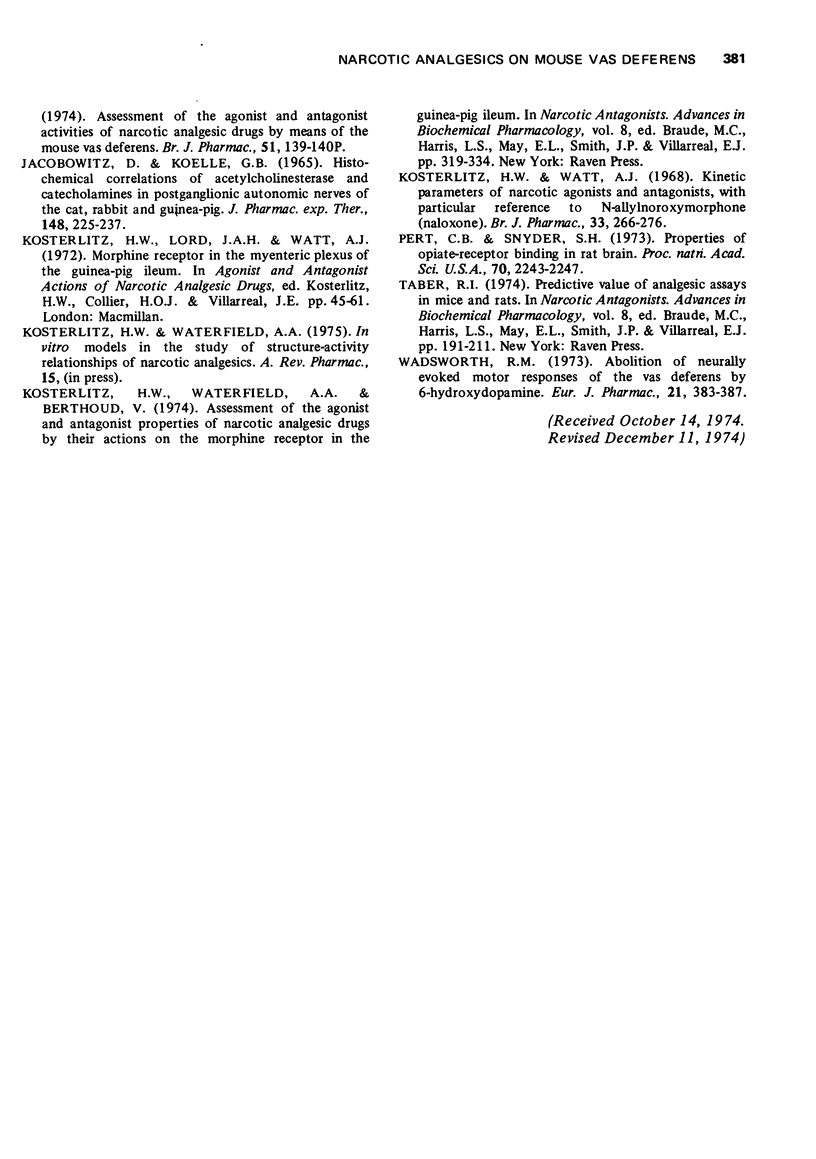Abstract
1. Morphine inhibits the electrically evoked (0.1-0.15 Hz, 1 ms) contractions of the longitudinal muscle of the mouse vas deferens but not of the rabbit, guinea-pig, rat, cat, hamster or gerbil. This effect is stereospecific and is antagonized by naloxone or naltrexone. 2. Normorphine is equiactive with morphine but its effects are more rapid in onset and decline. 3. In the mouse vas deferens, the resting outflow of tritium-labelled catecholamines is unaffected by morphine. The electrically evoked outflow is depressed by morphine or normorphine in a dose-dependent manner. The ID50 for inhibition of contraction and for depression of outflow is 0.5 muM. 4. The relative agonist potencies of compounds without antagonist component (codeine, pethidine, morphine, normorphine, heroin, levorphanol, Ba-20227, etorphine) show good correlation with the relative agonist potencies determined in the guinea-pig ileum and for analgesia in man. 5. For compounds with dual agonist and antagonist properties, the dose-response curves for agonist activity are shallow. When the lowest concentrations giving a depression of the contraction of the mouse vas deferens are used, a good correlation is obtained with the guinea-pig ileum. 6. The relative antagonist potencies of naloxone, nalorphine, levallorphan, and cyclazocine agree well with those obtained in the guinea-pig ileum; these, in turn, correlate well with the values obtained in the morphine-dependent monkey. 7. The fact that the agonist effects of drugs with dual agonist and antagonist action show little or no dependence on concentration, makes the mouse vas deferens particularly suitable for the assay of assay of antagonist activity. 8. As an assay preparation, the mouse vas deferens is less robust and consistent in its responses than the guinea-pig ileum.
Full text
PDF










Selected References
These references are in PubMed. This may not be the complete list of references from this article.
- ADLER T. K. Comparative potencies of codeine and its demethylated metabolites after intraventricular injection in the mouse. J Pharmacol Exp Ther. 1963 May;140:155–161. [PubMed] [Google Scholar]
- Ambache N., Dunk L. P., Verney J., Zar M. A. Inhibition of post-ganglionic motor transmission in vas deferens by indirectly acting sympathomimetic drugs. J Physiol. 1972 Dec;227(2):433–456. doi: 10.1113/jphysiol.1972.sp010041. [DOI] [PMC free article] [PubMed] [Google Scholar]
- Boadle-Biber M. C., Hughes J., Roth R. H. Acceleration of noradrenaline biosynthesis in the guinea-pig vas deferens by potassium. Br J Pharmacol. 1970 Dec;40(4):702–720. doi: 10.1111/j.1476-5381.1970.tb10648.x. [DOI] [PMC free article] [PubMed] [Google Scholar]
- Furness J. B. Transmission to the longitudinal muscle of the guinea-pig vas deferens: The effect of pretreatment with guanethidine. Br J Pharmacol. 1974 Jan;50(1):63–68. doi: 10.1111/j.1476-5381.1974.tb09593.x. [DOI] [PMC free article] [PubMed] [Google Scholar]
- Gyand E. A., Kosterlitz H. W. Agonist and antagonist actions of morphine-like drugs on the guinea-pig isolated ileum. Br J Pharmacol Chemother. 1966 Sep;27(3):514–527. doi: 10.1111/j.1476-5381.1966.tb01864.x. [DOI] [PMC free article] [PubMed] [Google Scholar]
- Henderson G., Hughes J., Kosterlitz H. W. A new example of a morphine-sensitive neuro-effector junction: adrenergic transmission in the mouse vas deferens. Br J Pharmacol. 1972 Dec;46(4):764–766. doi: 10.1111/j.1476-5381.1972.tb06901.x. [DOI] [PMC free article] [PubMed] [Google Scholar]
- Hughes J. Evaluation of mechanisms controlling the release and inactivation of the adrenergic transmitter in the rabbit portal vein and vas deferens. Br J Pharmacol. 1972 Mar;44(3):472–491. doi: 10.1111/j.1476-5381.1972.tb07285.x. [DOI] [PMC free article] [PubMed] [Google Scholar]
- Hughes J. Inhibition of noradrenaline release by lysergic acid diethylamide. Br J Pharmacol. 1973 Dec;49(4):706–708. doi: 10.1111/j.1476-5381.1973.tb08549.x. [DOI] [PMC free article] [PubMed] [Google Scholar]
- Hughes J., Kosterlitz H. W., Leslie F. M. Proceedings: Assessment of the agonist and antagonist activities of narcotic analgesic drugs by means of the mouse vas deferens. Br J Pharmacol. 1974 May;51(1):139P–140P. [PMC free article] [PubMed] [Google Scholar]
- JACOBOWITZ D., KOELLE G. B. HISTOCHEMICAL CORRELATIONS OF ACETYLCHOLINESTERASE AND CATECHOLAMINES IN POSTGANGLIONIC AUTONOMIC NERVES OF THE CAT, RABBIT, AND GUINEA PIG. J Pharmacol Exp Ther. 1965 May;148:225–237. [PubMed] [Google Scholar]
- Kosterlitz H. W., Waterfield A. A., Berthoud V. Assessment of the agonist and antagonist properties of narcotic analgesic drugs by their actions on the morphine receptor in the guinea pig ileum. Adv Biochem Psychopharmacol. 1973;8(0):319–334. [PubMed] [Google Scholar]
- Kosterlitz H. W., Watt A. J. Kinetic parameters of narcotic agonists and antagonists, with particular reference to N-allylnoroxymorphone (naloxone). Br J Pharmacol Chemother. 1968 Jun;33(2):266–276. doi: 10.1111/j.1476-5381.1968.tb00988.x. [DOI] [PMC free article] [PubMed] [Google Scholar]
- Pert C. B., Snyder S. H. Properties of opiate-receptor binding in rat brain. Proc Natl Acad Sci U S A. 1973 Aug;70(8):2243–2247. doi: 10.1073/pnas.70.8.2243. [DOI] [PMC free article] [PubMed] [Google Scholar]
- Wadsworth R. M. Abolition of neurally evoked motor responses of the vas deferens by 6-hydroxydopamine. Eur J Pharmacol. 1973 Mar;21(3):383–387. doi: 10.1016/0014-2999(73)90144-1. [DOI] [PubMed] [Google Scholar]


